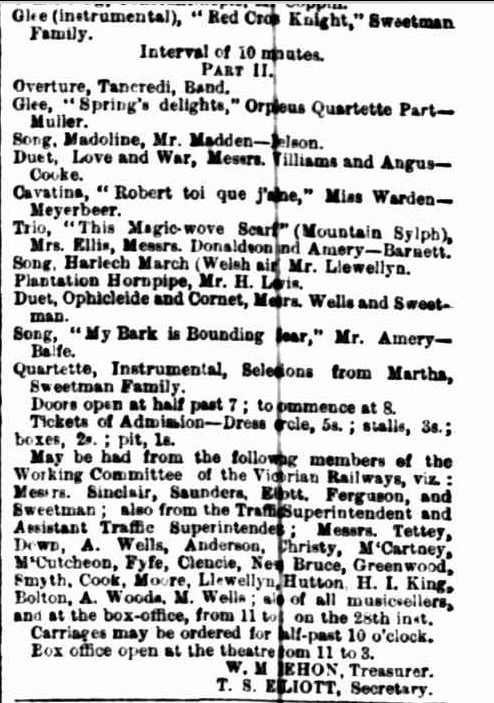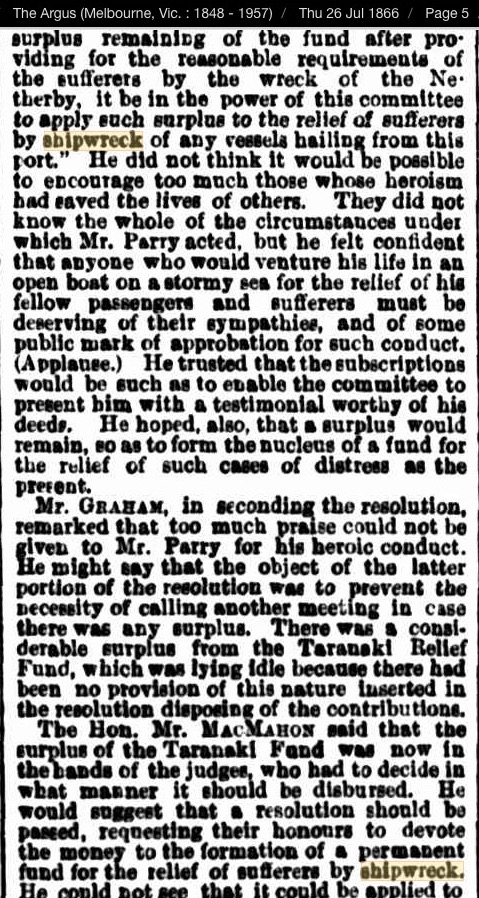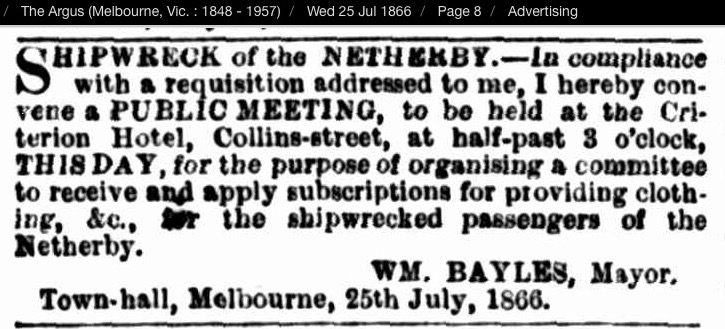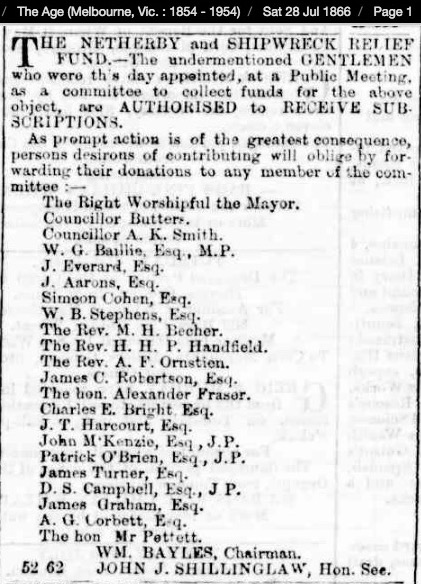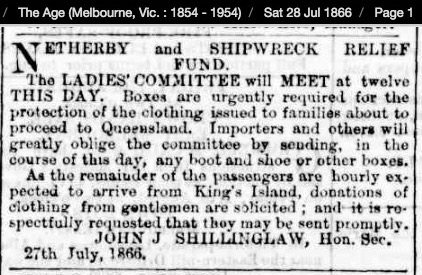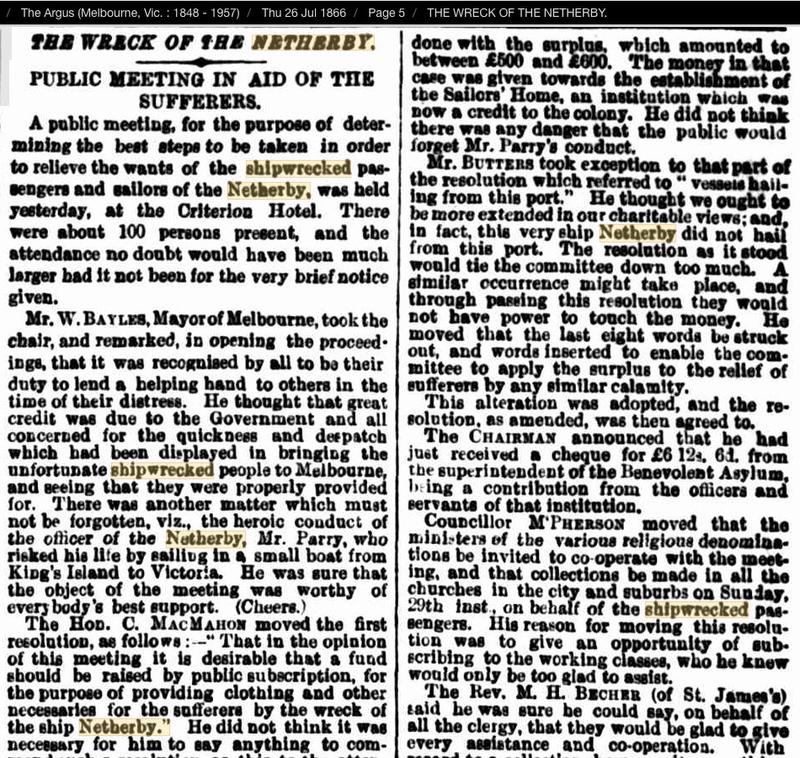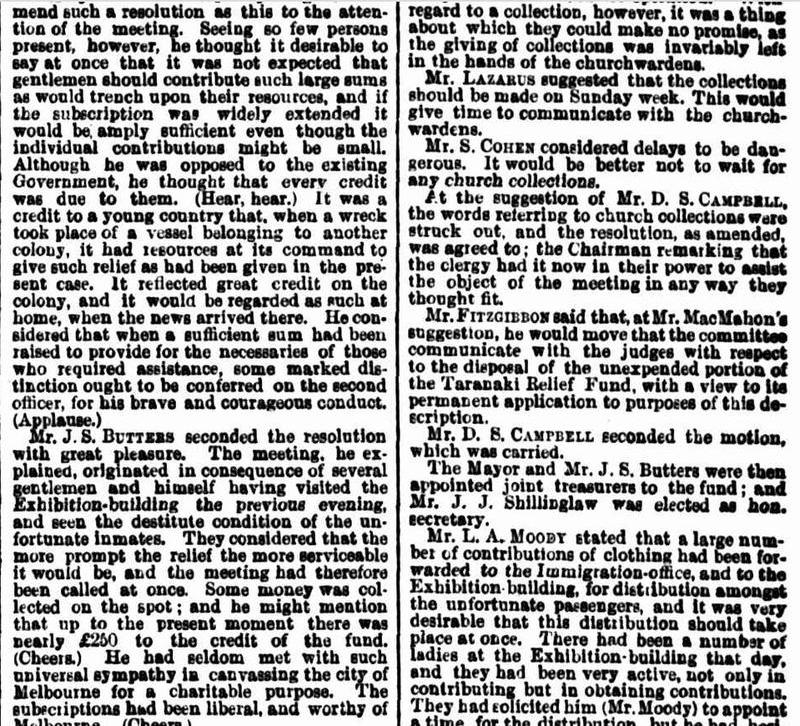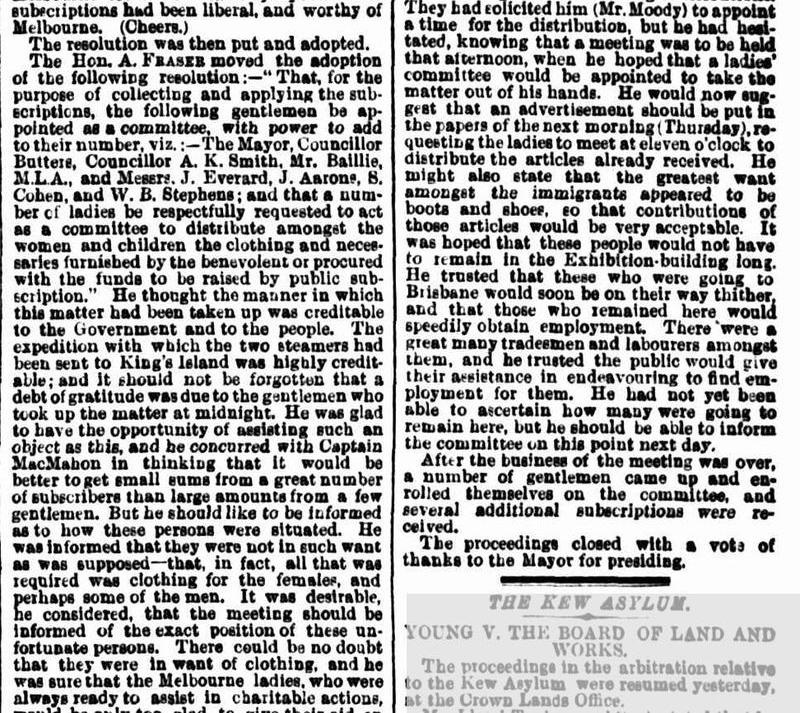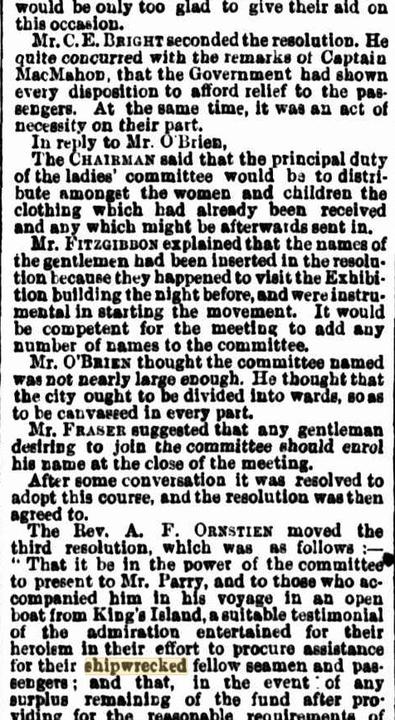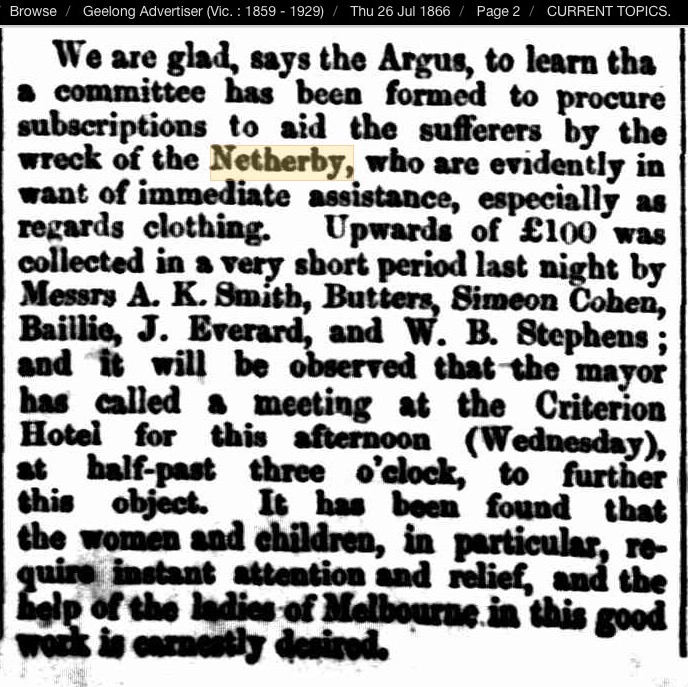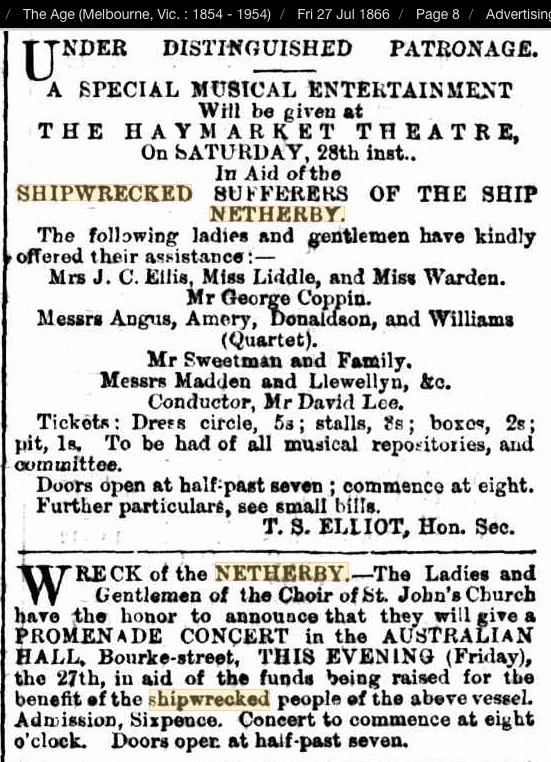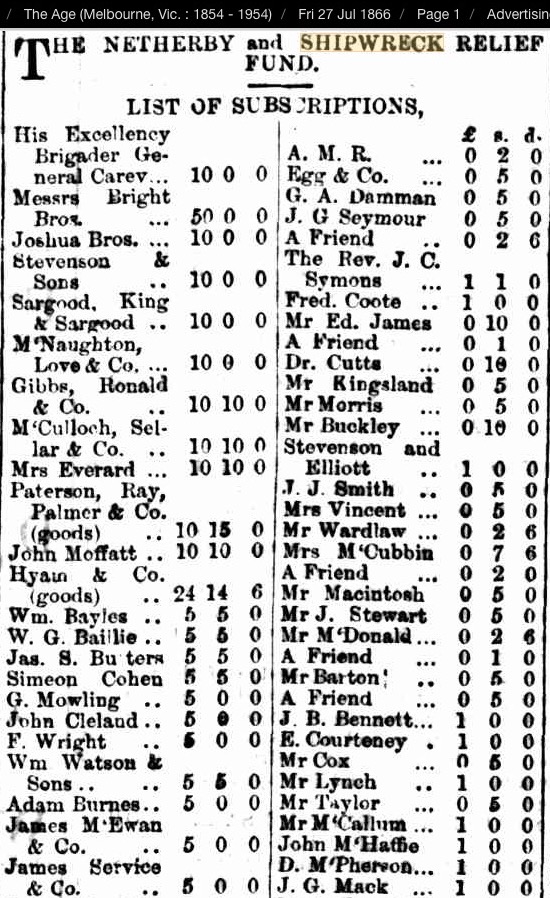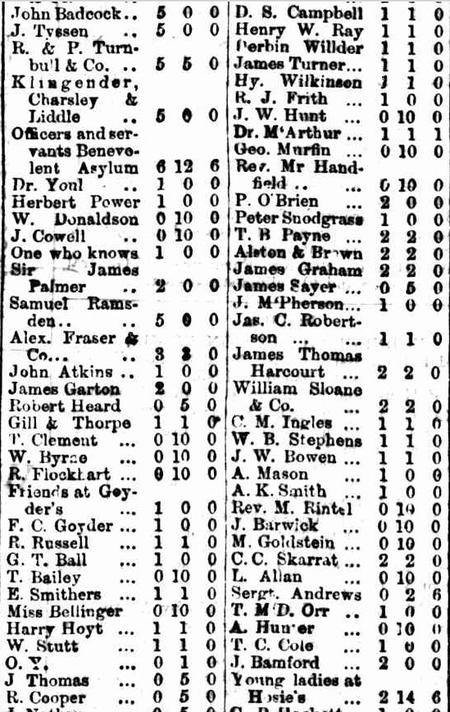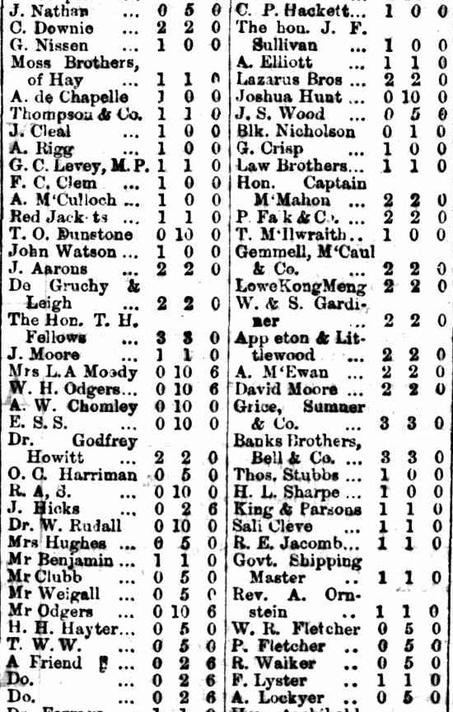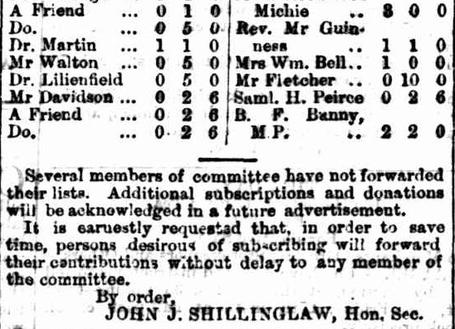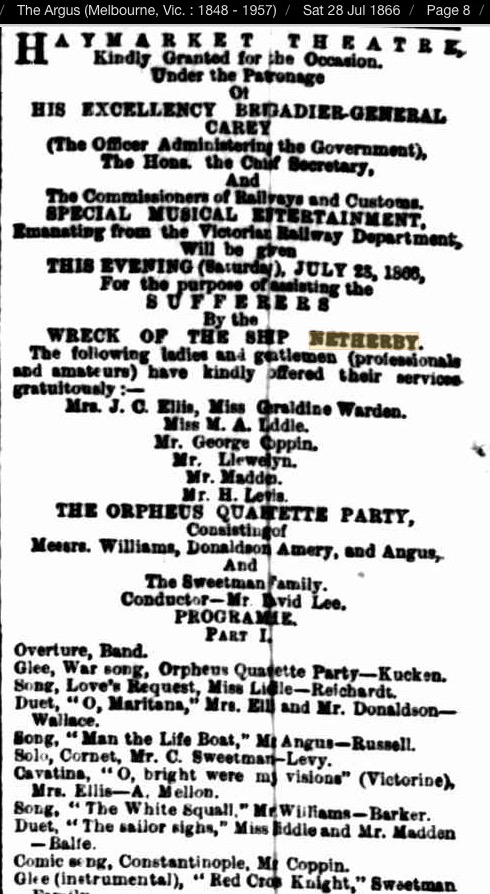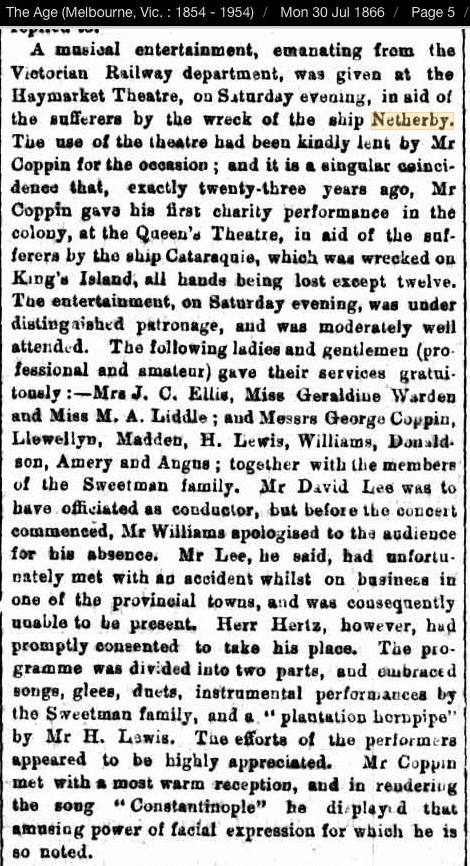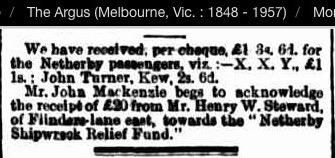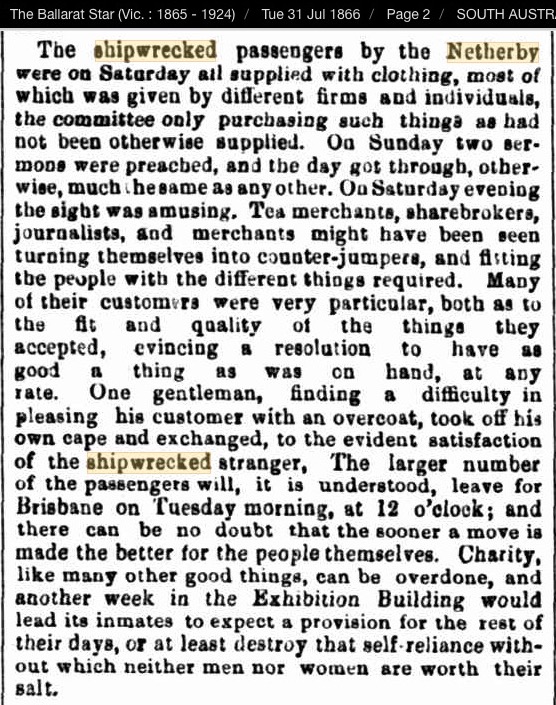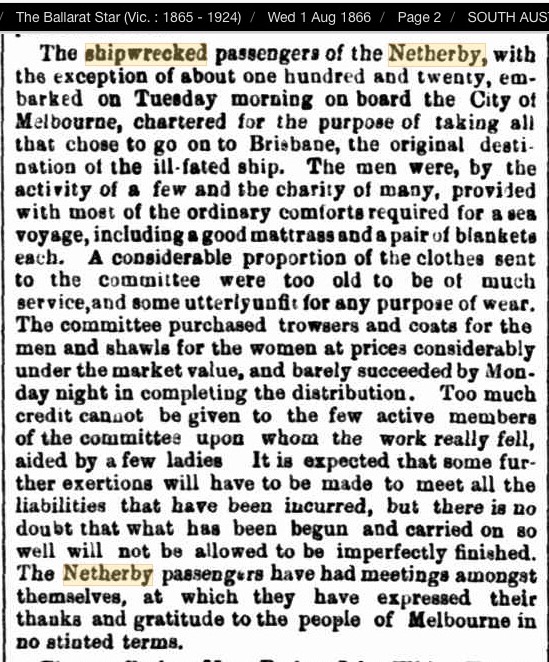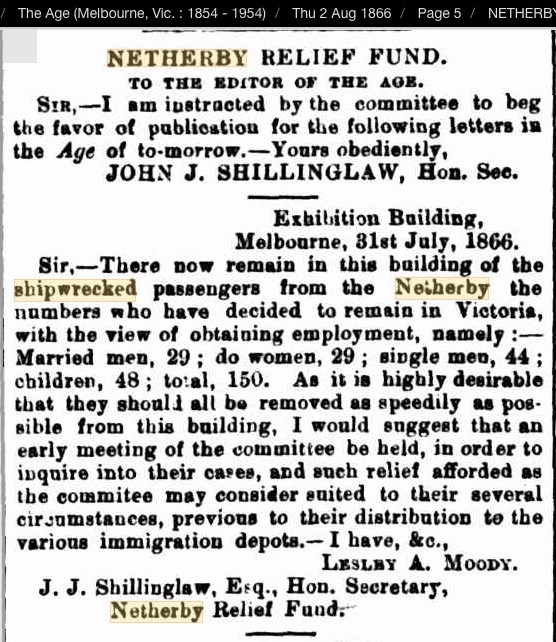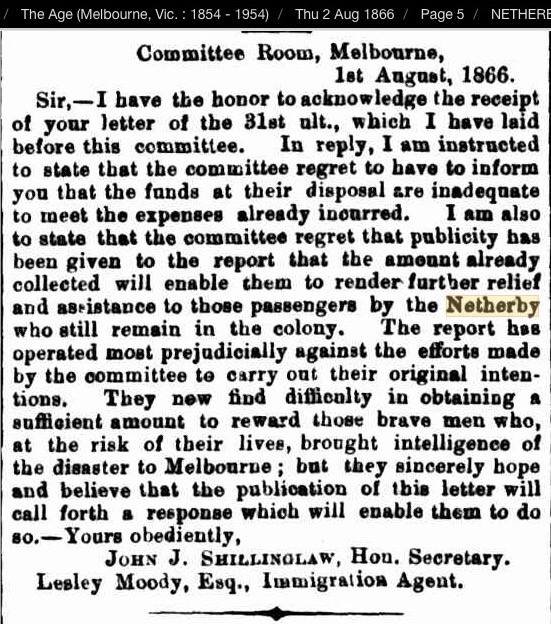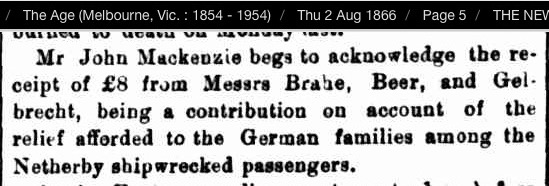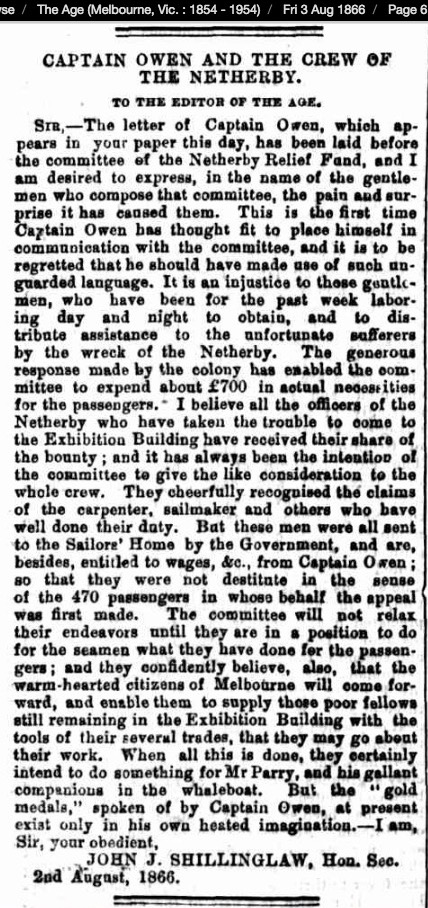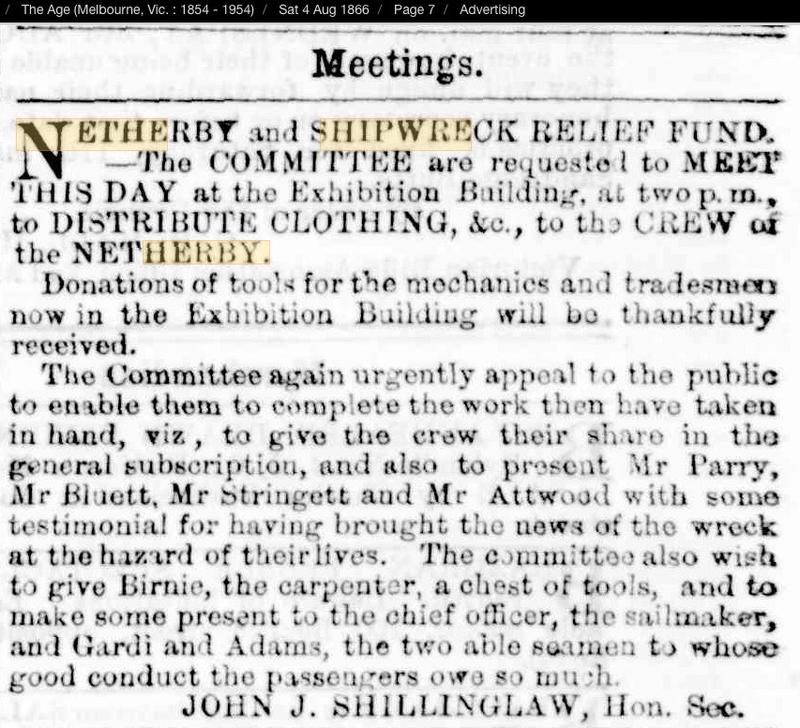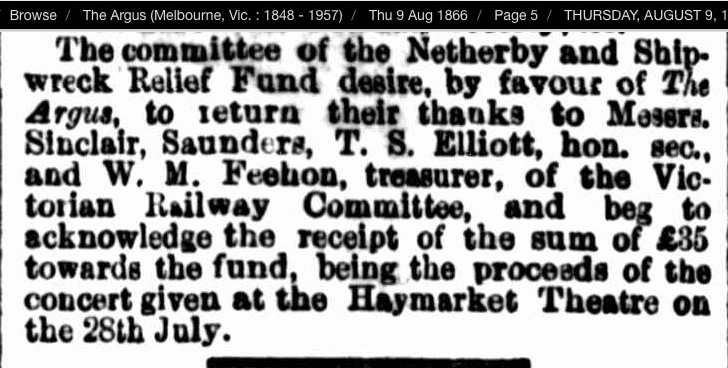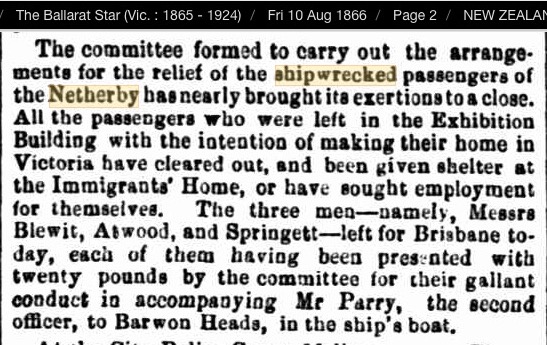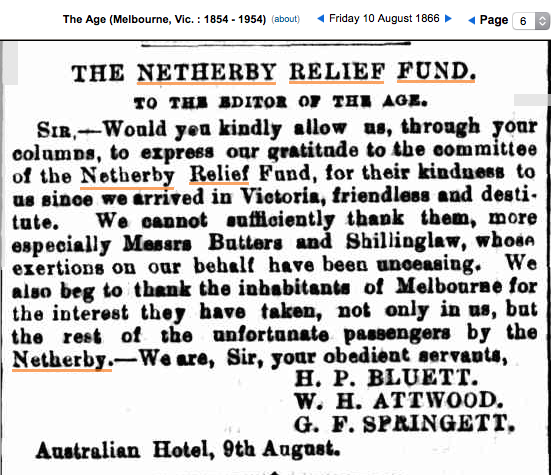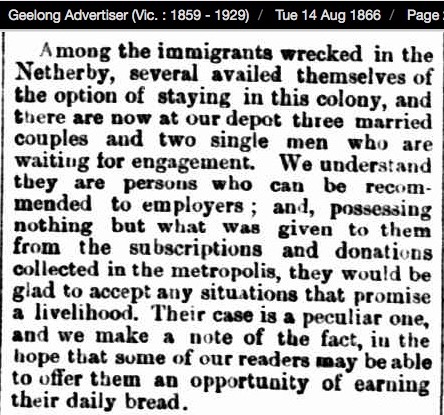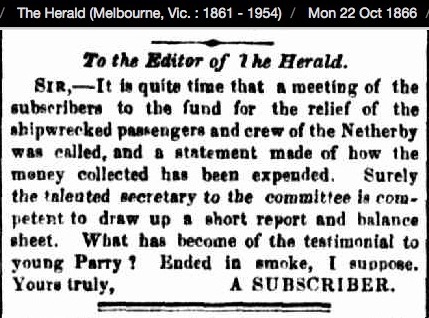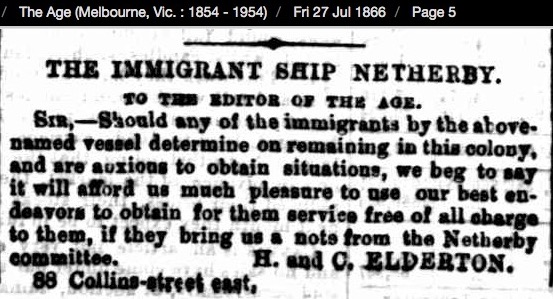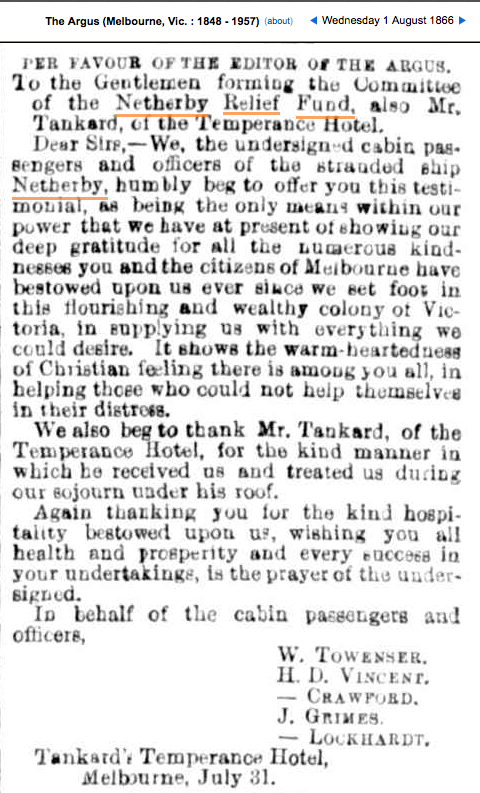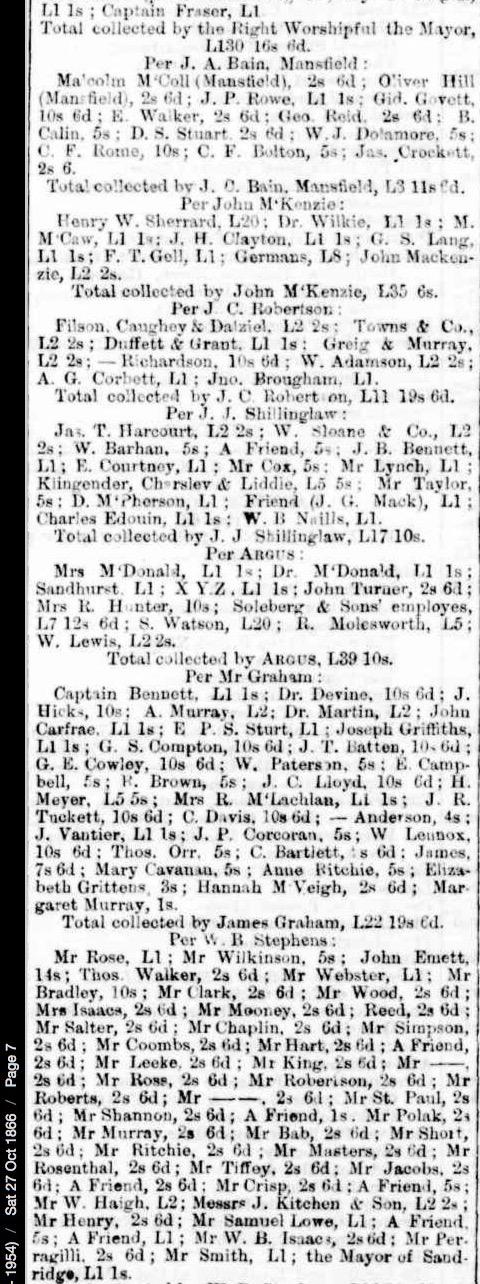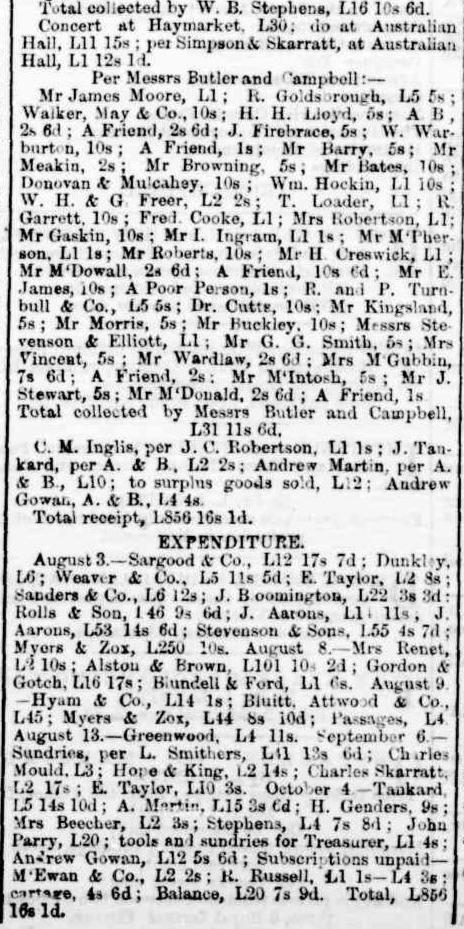The rescued passengers arrive in Melbourne and are provided with accommodation, clothing and relief by the Netherby Relief Fund which was speedily established at the request of
Mayor William Bayles.
From the moment hero John Parry got word of the shipwreck to Williamstown Harbour Master Capt. Charles Ferguson and the Premier, Chief Secretary James McCulloch (at his home at 1.15am Sunday morning) on Saturday 21 July, preparations had speedily begun in the Exhibition Building on William Street to house the bulk of the passengers under the organisation of Mr Lesley A Moody, Colonial immigration officer, and the Hon J G Francis, Commissioner of Customs. (See here for more details and photos of the various other locations passengers and crew were accommodated, including a map circa 1861 showing their journey from the train station pier at Williamstown to the city, and an 1866 visitors guide that may well have been given to each of the passengers who remained in Melbourne).
Ample supplies of beds and bedding had been provided along with necessities to turn the building into a barrack, along with a large cooking apparatus and tables and chairs. Mr Francis directed volunteers to divide the building into temporary compartments, one for the married couples, and other classes were separated into other compartments. Single men were placed up in the gallery.
In the recollections of police officer John Sadleir years later he noted that due to letters to the papers about preserving decency and privacy for passengers: “… screens in the shape of curtains were supplied for privacy and, as this plan greatly increased the risk of fire, it was arranged that a special staff of firemen and policemen be employed.” (John Sadleir, 1833 – 1919, later instrumental in the capture of the Kelly Gang).
Dr Kearney of the ship Star of India and Dr M’Gaurin (or McGauren) of the Immigration Depot and medical officer of the Gaol, both made themselves available and stayed through the first night with the passengers. Dr McCrea also gave his services. Mr Todd, the travelling inspector of public works improved the appliances for keeping the building healthy and as warm as possible (remembering this was winter in Melbourne!). A passenger later thanked Mr J G Francis, Mr Moody, Mr O’Connor, Mr Heath and Mr Bunning (and others whose names he did not know) for carrying out all the generous duties in the Exhibition building, in a letter to the papers.
On Tuesday 24 July, 10 days after the wreck, the passengers began arriving in Melbourne via the vessels Victoria and Pharos and then a train (arranged by Mr Jeremy, the railway traffic superintendent) from Williamstown to Spencer Street Station. Melbourne's generosity began immediately via the cabmen assembled in the vicinity of the station to take passengers to the Exhibition building, the Immigration Depot and the Sailors Home, for which service the men unanimously declined to receive any remuneration. The owners of the cars were named as; Messrs John, Bernard and Edward Mahon, and the drivers; Peter Kelly, Thomas Haighow, John Tew, Morley Clark, Joseph Fitzpatrick, Martin Whelan, Bernard Mahon, John Mahon, Thomas Laidman, John Keating and James Welsh.
Mayor William Bayles called a meeting for Wednesday 25 July at the Criterion Hotel Collins Street West to establish the committee and relief fund and had already raised 400 pounds in subscriptions by the end of that day. A Ladies Committee was formed to administer to the needs of the women and children, including the immediate sewing of clothes. The Relief Fund Committee discussed at length how to reward Parry and the men who accompanied him to seek rescue. It was also resolved to order the surplus of the Taranaki Relief Fund to increase the relief fund. The Geelong Advertiser states that a large number of influential men assembled, but not so many as would have congregated had the meeting been convened at a more convenient hour for businessmen! During the meeting the Mayor announced he had just received a cheque for £6 12s 6d from the employees at the Benevolent Asylum.
Newspapers of the day make reference to many benefactors and donations:
"...but amongst them were a load of apples and other fruits, presented by Mr T H Hadley, late member of the Legislative Assembly, who rendered valuable assistance throughout the day; a number of books, periodicals and newspapers from Messrs Robertson and Stephens; and a couple of cases of porter, contributed by the hon. J. G. Francis, for the use of the women, and more especially of those acting as nurses. One of the most interesting, though not, perhaps, the most important contributions to the little stock of comforts realised by means of these voluntary offerings, consisted of half-a-dozen of new-laid eggs, presented by an elderly lady who thought they might prove beneficial to some of the weaker members of her own sex".
“... had conceived the idea that the immigrants would desire to communicate with their friends on the old country by the earliest opportunity, and it was accordingly resolved that every facility should be afforded them of writing by the mail about to be despatched for Europe today. To give effect to this intention, an abundant supply of pens, ink, paper and stamps was distributed at an early hour in the forenoon. … In order to render complete the facilities afforded for carrying on correspondence, a post office had been improvised for the occasion, and all letters deposited in this small establishment were despatched at the charge of the contributors to the general relief fund”.
“Contribution of many necessaries, of considerable value in the aggregate, were sent in, for the relief of the unfortunate people; and though we have been unable to obtain a list of all of the donors, as many gifts were sent in anonymously, it seems but fair to mention those whose names are recorded by the officers in charge of the establishment. The Messrs Degraves sent in ten bags of flour; Mr Hosie, confectioner, a number of buns for the children; Messrs Smith and Son, a bag of biscuits; and Messrs Rees, R Palmer and Co, Firth, Schoohberg, John Walters, Low, Clements, Greaves, Aldwincle, Sargood and co, Mrs T Fellows, and Messrs Tyson and J Barlow, clothing; and Mr McKensie, a quantity of boots and shoots”.
“… amongst the most interesting, as well and most useful articles sent in, may, however, be mentioned three sewing machines, the loan of which was given by Messrs Willcox and Gibbs, for the use of the single girls who are stationed at the old immigration depot in King Street”.
“All day Thursday parcels of clothes, cases, and trunks of boots, hats and caps (old and new), were sent in, the leading soft-goods warehousemen and merchants being the chief contributors. The gifts were not confined to apparel, but cases of port wine, spirits, oranges, biscuits and even lollypops for the children, were forwarded by persons in all ranks of life”.
“… a parcel of combs from Moubray, Lush and Co; a ton of flour from Mr Degraves; a hogshead of excellent ale from Mr Wild of the Collingwood Brewery; four dozen of porter and one dozen of port wine for the women from Mr Godfrey; enormous bundles of male and female clothing from the softs goods men such as Sargood King and Sargood, Paterson Ray Palmer and Co; and Soleberg and Sons”.
“At half past ten on Thursday morning the Ladies’ Committee met at the Exhibition Building and went to work with good will to distribute the various articles that had either been bought for or gratuitously presented to the shipwrecked immigrants. Several tables had been erected upo which were piled heaps of linen, sheets, towels, underclothing of every description, stockings and a large quantity of boots and shoes, rolls of flannel, men’s and women’s apparel of every make and fashion. Hats were there in abundance from the billycock to the super fine silk. Women’s hats were ready for distribution and even fashionable bonnets. Crinolines were not forgotten and many articles of finery had been sent as donations. The ladies went to work vigorously counting stockings, inspecting dresses, measuring off calicoes and flannels, working in fact with a heart and a will.
“8 pounds was received from Messrs Brahe, Beer and Gelbrecht, to be afforded to the German families among the shipwrecked passengers.”
A call out was made for 500 trunks or boxes to contain the clothing and donated items such as tools so passengers could pack what was needed for the onward voyage to Queensland. There was also a call out for shoes and boots as any that had made it ashore were ruined by salt water and dilapidated, and one for tools for the mechanics and tradesmen who had lost their tools of trade to the sea.
On Friday 27 July an amateur concert was given in the newly built Australian Hall in Bourke Street courtesy of the proprietor Mr Hoyt, by members of the choir of St John’s Church for approximately 400 persons who paid a fixed rate of 6d to raise funds.
The Argus reported on 27 July that the Relief Fund has so far raised £400 and that the City Baths will be opened for free for the passengers.
On Saturday 28 July, a concert was held at the Haymarket Theatre to raise funds for the relief fund. Owner George Coppin provided the use of his theatre and expertise. Entertainers included Mrs Ellis, Mrs Fox, Miss Liddle and Mrs Turner; Messrs Angus, Amery, Donaldson, Blanchard, Madden and Williams; members of the Williamstown Artillery Brass Band, Mr Sweetman and family, and conductor Mr David Lee. 35 pounds was raised.
On Sunday 29 July a Divine Service was conducted in the Exhibition Building in the morning and again at noon. An excellent sermon was preached to them in the morning by the Rev Mr Johnston of the Seamen’s Chapel. In the afternoon an equally eloquent discourse was delivered by the Rev Mr Cope, Wesleyan Minister.
Dinner was a good old English fare of roast beef and plum pudding and bottled beer. The children have been under the care of Messrs McCutcheon and T McPherson.
“Yesterday (Monday 30th July) was the last day of distributing clothes; and the committee have spent about £500 on new garments, so divided them that every man had a good new fit-out of thoroughly serviceable clothes, which included coats, hats, waistcoats, trousers, boots, socks, flannel shirts, pocket handkerchiefs, and towels, and the women were each presented with a warm shawl in addition to the other garments of which complete sets were given them on Friday and Saturday last”.
On Tuesday 31 July, those that were embarking on the City of Melbourne to Brisbane left the Exhibition Building after giving three cheers to the people of Melbourne for the hospitality given.
The men were provided with most of the ordinary comforts required for a sea voyage, including a good mattress and a pair of blankets each. Every man had a good new fit-out of thoroughly serviceable clothes, which included coats, hats, waistcoats, trousers, boots, socks, flannel shirts, pocket-handkerchiefs, and towels. The women were each presented with a warm shawl in addition to other garments of which complete sets were given to them.
Prior to boarding the City of Melbourne the cabin passengers, Mr Townsend, Mr Vincent, Mr Crawford and Mr Grimes, and Purser Lockhardt; wrote to the editor of the Argus thanking the relief fund gentlemen and Mr Tankard of the Temperance Hotel, along with the citizens of Melbourne, for the kind hospitality bestowed upon them.
On Wednesday 1 August, Captain Owens wrote to the editor of the Age stating that his crew had been treated with coldness and indifference when they applied for a change of garments to cover their nakedness. “No doubt my good and deserving crew were overlooked by the committee on account of their anxiety to succour those passengers who were to leave by the steamer. If there are any articles of clothes remaining, my destitute crew will receive them with heartfelt gratitude. To the praise of the honourable committee, I must say that they told my apprentice (an orphan boy) to go about the building and select for himself whatever he stood in need of”.
Honourable Secretary of the Relief Fund, John J Shillinglaw, responded to Captain Owens letter in the Age the next day. “This is the first time Captain Owens has thought fit to place himself in communication with the committee, and it is regretted that he should have made use of such unguarded language. I believe all the officers of the Netherby who have taken the trouble to come to the Exhibition Building have received their share of the bounty; and it has always been the intention of the committee to give the like consideration to the whole crew. They cheerfully recognised the claims of the carpenter, sailmaker and others who have well done their duty. But these men were all sent to the Sailors’ Home by the Government, and are, besides, entitled to wages by Captain Owens; so they were not destitute in the sense of the 470 passengers in whose behalf the appeal was first made. The committee will not relax with their endeavours until they are in a position to do for the seamen what they have done for the passengers; and they confidently believe the warm-hearted citizens of Melbourne will come forward and enable them to supply those poor fellows still remaining in the Exhibition Building with the tools of their several trades, that they may go about their work.”
On Thursday 2 August there remained 150 people in the Exhibition building, all choosing to remain in Victoria with a view to obtaining employment. They consisted of 29 married couples, 48 children, and 44 single men. Mr Moody made a request to the relief fund committee for a meeting to be held to discuss their individual cases, provide further relief, and move them on from the building to more convenient locations.
On Saturday 4 August, Honourable Secretary John J Shillinglaw called a committee meeting to distribute clothing and tools to the crew of the Netherby and requested donations of tools for mechanics and tradesmen. The committee wished to give Noah Birnie, the ship carpenter, a chest of tools, and make some presents to the chief officer, the sailmaker, and Gardi and Adams who had all shown good conduct. The committee presented twenty pounds to Messrs Bluett, Attwood and Springett who had accompanied Parry, for gallant conduct. It is noted in the Ballarat Star those men left for Brisbane on 10 August.
Before departing Melbourne, passengers Bluett, Attwood and Springett wrote to the editor of the Age on 9 August stating they wished to express their gratitude to the committee of the relief fund, for their kindness to them since they arrived in Victoria, friendless and destitute.
The Sydney News reported on 16 August that by the 3rd a total of £700 had been raised and £535 had been distributed.
SOURCES: Above is compiled by site administrator Karina via all of the available newspaper articles on Trove, including those already included throughout this website and also those included below. I have also undertaken my own research about the various people on the committee and aiding in the relief – to get an idea of who these people where who came to the immediate aid of all of our stricken ancestors. For this I used Trove and also found many of them listed in the Parliament.vic.gov.au archives, http://adb.anu.edu.au/biography, NLA, State Library Vic, www.cv.vic.gov.au, http://citycollection.melbourne.vic.gov.au/ and various Melbourne history websites. If it is only a possible match I have specified ‘possible’. I have created a spare page HERE that includes all the extra information I found on these very prominent people of Melbourne.
In these two photo scrollers (above and below) I have included photos or portraits of members of the Relief Fund committee, or other pictures relevant to them where no facial images were found. I have also included pictures of other people mentioned in my above notes, or small articles such as death notices where I was unable to locate a facial image. Hover over the scroller to pause it.
The Netherby Relief Fund Committee members
- William M Bayles, Chairman, treasurer, The Right Worshipful the Mayor. (1820-1903. Merchant and ship owner. Mayor of Melbourne from 1865-1866).
- John Joseph Shillinglaw Esq, Hon Secretary. (1831-1905, public servant, author and historian. From 1856 to 1869 he held the position of Govt Shipping Master, administering laws relating to seamen).
- Councillor James Stewart Butters esq, treasurer. (1832 – 1912. Stockbroker. Principal partner with W G Baillie in the stock broking firm Baillie and Butters – dissolved 1869. Mayor of Melbourne in 1867-8 and entertained the visiting Duke of Edinburgh. Relocated to Fiji in 1870 to invest in plantations of sugar, coffee, Manilla hemp, cotton and became a member of Parliament there and also the Speaker before returning to Melbourne in 1874).
- Councillor A K Smith. (Alexander Kennedy Smith 1824-1881. Civil engineer. Mayor of Melbourne 1875-6. Member of the Lower House, died while holding a seat on the Melbourne City Council and Member for East Melbourne).
- William Gray Baillie esq, MP MLA. (Stockbroker. First chairman of the Victorian Stock Exchange 1861, partner in Baillie and Butters stockbroking firm – dissolved 1869. Member for Castlemaine in 1866 and 1868, resigned 1870 when insolvent. Murdered in 1871 in Fiji, where he had relocated to be a cotton planter, by his male partner Mr Henry Scott, who later suicided. Baillie also had a wife Elizabeth Jane and daughter Marian Grace who lived next door).
- John Everard Esq, JP. (1825-1886, tea broker at 69 Collins St West. 1858-74 MLA Member for district of Rodney North Gipps Land, chairman of the Separation Committee for Hotham Ward. 1859 appointed Magistrate for city of Melbourne. 1869 on the board of the Royal Commission on the practice of paying or compensating members of the legislature).
- J Aarons, Esq. (Of 6 Collins St East. Treasurer of the Freemasons’ Charitable Institution. A trade assignee, listed on many insolvent estates and in auction notices with SH Cohen & Co)
- Simeon Cohen, Esq, JP. (1832-1895. Merchant and Importer, president of the Melbourne Hebrew Congregation, philanthropist.)
- W B Stephens Esq. (Bookseller and stationer, 15 Collins St West. Went on to publish the Netherby Gazette. Also produced Stephens Maps of Melbourne. Member of the Order of the Australian Templar Knights. An etching of him exists in the Australian Templar directory but it is not yet scanned online)
- The Rev M H Becher. (Michael Henry Becher, Canon of St James Pro-Cathedral cnr Collins and William sts. Died 1883. Son Francis moved to WA town of Harvey in 1905, grew oranges, which Harvey is still famous for today).
- The Rev HHP Handfield. (Rector from 1854 until his death in 1900. Church of England, Anglican Church of St Peter’s. Third church built in the colony in 1846. Committee member and secretary of the Melbourne City Mission from 1854 to 1859).
- The Rev AF Ornstien. (Jewish Reverend Abraham Frederick at the Bourke St synagogue, retired October 1874, died 1895).
- James C Robertson, Esq. (Possible match for 1822-1893, listed in the blue book for the colony for governors etc. He is listed as professor theory and practice of medicine, MD Melbourne Hospital).
- The Hon Alexander Fraser. (1802-1888. 1856-7 Assistant Minister for Conservation and had Fraser National Park named after him in 1957, it is now Lake Eildon NP. Member of the Legislative Council for the North West Province from 1858 to 1881. Minister for Public Works 1872 to 1874. Died 1888 age 87).
- Charles E Bright, Esq. (Possible match Charles Edward Bright 1829-1915. In 1870-71 he was a trustee of the Public Library, Museums and National Gallery of Vic board).
- JT Harcourt Esq. (Likely James Thomas Harcourt 1813-1893 of Footscray. 1863 charirman of the Regatta Committee. 1866 trustee of the Victorian Deaf and Dumb Institution. In 1874 he was on Royal Commission panel into Industrial and reformatory schools and sanatory [sic] station. 1874 vice chairman Australian and European Bank. 1876-78 treasurer Melbourne Benevolent Asylum).
- John McKenzie Esq, JP. (1864 board member of the London and Lancashire Fire and Life Insurance Companies, Victorian Board. 1867 Director of the Commercial Bank of Australia Ltd).
- Patrick O’Brien Esq, JP. (1863 Chairman of the Hawthorn Bench of Magistrates and treasurer of the Irish Relief Fund. 1886 director of the Land Mortgage Bank of Victoria Ltd).
- James Turner Esq. (Possible match, died aged 48 15 May 1867 after an accident. Of Oakden, Alma Rd St Kilda, a merchant. Possibly Mayor of St Kilda Dec 1866 and at the time of his death.).
- DS Campbell Esq, JP. (1858 President of Melbourne Cricket Club. MLA in 1859-60. 1860s chair of the Horticultural Improvement Society. Of Richmond Hill, with a newsworthy garden).
- James Graham Esq. (1866: Vice chairman of Australasian Insurance Company, Fire, Life and Marine. Director of The Colonial Life Assurance Company. Of Messrs Graham Brothers and Co – importers, including of a ‘magnificent Yorkshire draught horse named Sultan’).
- AG Corbett Esq. (Andrew G Corbett. 1860s and 70s auction notices refer to him as a machinery merchant and owning a large machinery yard at 16 Franklin St, later Queen St – supplying steam engines, steam threshers, boilers, portable hand cranes, mining plants and agriculture implements to engineers, contractors and mining companies. Traded as A G Corbett and Son. Listed as a steward on the Melbourne Hospital Annual Ball committee each year along with many other names on this list. 1877 articles reference him building an ammonia manufactory near the gas works Reilly St).
- The Hon Mr Pettett. (William Henry Pettett Esq, JP. 1814-1871. 1864 Member of the Legislative Council, extensively connected with squatting and land selection in Ararat district. 1863 on the board of the Hawthorn Bench of Magistrates. 1863-4 Mayor of Hawthorn. Died 1871).
OTHER: Councillor’s MacMahon (Captain McMahon MLA. Possibly Sir Charles McMahon 1824-1891 – still confirming) and McPherson (of Sandhurst) are also referred to in the minutes of the public meeting held 25 July. Others mentioned but not in the initial published list of committee members are Mr Lazarus, Mr Fitzgibbon and Mr Lesley Alexander Moody (Colonial immigration officer at the time. In 1875 he was Vic Inspector of Distilleries. Born 1818, Died 1883 aged 65. Of South Yarra).
Ladies Committee
Based on the surnames, many on this committee seem to have been the spouses and daughters of the male committee members.
Mrs Adamson
Mrs Binden (possibly wife of Samuel Henry Bindon 1812-1879)
Mrs Butters (wife of James Butters)
Mrs Baillie (Elizabeth Jane, wife of WG Baillie)
Mrs Bickford
Mrs Becher (Philippa, secretary Ragged Schools Association and many charity committee lists. She and husband Rev Michael Becher were also on the board of the Melbourne City Mission.)
Mrs Copeland
Miss Ellis/s
Mrs A Fraser
Mrs H Fraser
Mrs Feldheim
Miss Fenwick
Mrs House
Mrs Harcourt
Miss Harcourt
Mrs Hoonaby
Miss Horrall/Horred
Mrs Jude
Mrs Lehmann
Mrs L A Moody (wife of immigration agent Leslie Moody)
Miss Mackay
Miss Minton
Mrs O’Connor
Mrs O’Rafferty
Mrs R S Pyke (Or RT)
Miss Roche
Mrs A K Smith
Miss Smith
Mrs Walsh
Miss E Watt
Mrs Chas. Watt.
See Captain Owen's page for the context to this letter.
27 October 1866, The Age. The Netherby Relief Fund published their final report below showing every subscriber
and the expenditure. I have put stars beside references made to rewards that were paid out of the Fund.
*
*
*
*
*
*
